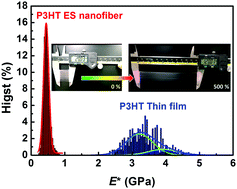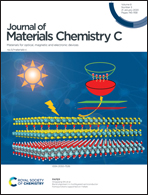Electrospinning-induced elastomeric properties of conjugated polymers for extremely stretchable nanofibers and rubbery optoelectronics†
Abstract
The appealing advantage of using an electrospinning technique to improve the elastomeric properties of conjugated polymers is demonstrated in this study. It is revealed that the electrospinning process can strengthen the low-crystalline feature of the prepared nanofibers. By combining the use of a polymer with low glass transition temperature, extremely stretchable nanofibers can be successfully prepared. P-type poly(3-hexylthiophene-2,5-diyl) (P3HT) electrospun (ES) nanofibers show a low Young's modulus of 0.448 GPa and still exhibit a high hole mobility of >10−2 cm2 V−1 s−1 even under an external strain of 500%. Based on these prepared P3HT ES nanofibers, a fully stretchable field-effect transistor (FET) and photomemory are realized. Besides, stretchable n-type poly{[N,N′-bis(2-octyldodecyl)naphthalene-1,4,5,8-bis(dicarboximide)-2,6-diyl]-alt-5,5′-(2,2′-bithiophene)} (N2200) ES nanofibers are also successfully prepared with strain tolerance up to 400% strain, showing the general applicability of our proposed method.



 Please wait while we load your content...
Please wait while we load your content...